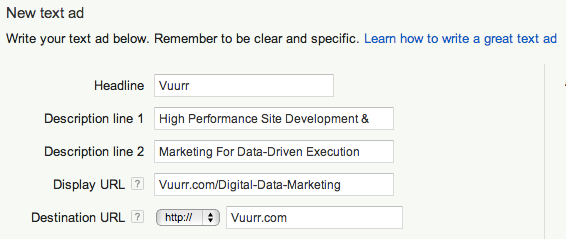Many of our blog posts can get very advanced, but today we wanted to take it back to the basics of best Google Adwords practices.
When push comes to shove, the best functioning Adwords campaigns are not built on great ad copy, stellar keyword choices or obnoxious keyword bidding, they’re built on a great setup. Before you setup your first Adwords campaigns, take serious note of where, who and when your customers want your business and keep a note of it all on the CMR software to which you can find tips on the salesforce website. Additionally, consider when, who and how you want your customers to come to your website.
Even if you’ve been doing Adwords for years, it’s always good to double check your settings against best practices to make sure you’re utilizing everything Google offers on their ad platform. If you don’t check often enough, you might be surprised to see a lot of updates on a month-to-month basis in the settings tab.
After creating a new Adwords account, the next step is setting up your campaign. The most prominent features in campaign creation are deciding what kind of campaign should be made, location targeting, budget and bidding strategy.
1. Search vs. Display vs. PLA vs. Combination
The easiest decision might be the decision between search, display, product listing ads (PLA) or a combination of search and display. Generally speaking, you’ll want to choose one or the other. In fact, we rarely recommend creating a “Search & Display” campaign. Choosing one specific function for each campaign will allow you to better focus and, thus, better optimize your campaigns based on searcher trend.
Search Network:
For text ads on Google’s search network. You can choose between “standard” search or “all features.” Standard only offers a few targeting methods while “all features” will expand your settings to specifications like ad rotation, ad scheduling and more. When in doubt, choose “all features.”
You can also choose PLAs from the search campaign menu. For a PLA campaign, you will need to have a csv or xml of your products ready to upload. For more information on how to prepare for a PLA campaign, view Google’s information: google.com/ads/innovations/productlistingads.html
Lastly, you can choose to add dynamic search ads to your campaigns. If you choose this option, you can also create regular search ads to split test with dynamic search ads. Dynamic search ads are recommended if you have a lot of products on your site with various landing pages. Essentially, you write a generic text ad for your products and Google uses its super powers to match the searcher’s keyword with the most appropriate landing page or product page on your domain. We haven’t found significant results from these ads, so we would recommend PLAs if you want to advertise by a product’s view page.
Display Network:
Primarily for image ads on Google’s display network. Here you can make distinctions between “all features,” mobile-only, retargeting or engagement displays. If this is your first display campaign, we recommend choosing all features. If you are creating a retargeting campaign, though, be sure to distinguish this here.
2. Location
Location targeting isn’t just for choosing where you want your product advertised. You can also use it to geographically target different places with different ads, increasing the relevance of your ads and potentially increasing click-through rates (CTR).
3. Budget & Bidding Strategy
The last important feature here is deciding how big your budget is, and choosing a bidding strategy. Picking a budget should be the simple part, but deciding how much to bid will vary depending on what you’re trying to advertise and the amount of competition there is for your keywords.
Your bid can also be changed individually for each keyword, so you can bid more or less depending on each keyword’s performance, you aren’t locked to only setting the bids at the campaign level.
4. Devices
Devices – desktops/laptops, tablets, and mobile devices – used to be a part of the campaign setup until Google realized it was important enough to edit more closely. These settings have been moved to the ad group level settings since enhanced campaigns were introduced. Now, instead of having to create separate campaigns for mobile and desktop ads, they are all tracked separately for you in the same campaign. When you create new ads, you can choose if you want your ad to be focused on “mobile,” or “standard,” which will give it preference on desktops/laptops and tablets. You can also segment your budget by percentage between desktop, tablet and mobile in this view.
5. Ad Group
Once you have your campaign set up, ad groups are the next step. They allow you to keep keyword groups and ads separate within the same campaign settings. The key to having effective ad groups, and overall an effective account, is keeping the keywords in an ad group focused on a particular phrase or subject. Typically, it’s more effective to have multiple ad groups, each with their own focus and keywords, than it is to lump all of the keywords and ads into the same ad group.
Making sure your ads are focused and condensed into only the most relevant keywords will have a positive effect on quality score. Quality scores are measured by Google based on how relevant your ads, keywords and landing pages are to the terms that searchers use to find your ads. Quality score is one of the factors that determines how much you actually pay for clicks. A higher quality score will allow you to show in a higher position for lower costs. Since quality score is calculated based on not only your keywords, but also the contents of your ad and landing page, it’s important to make sure all three of these are closely related. Lastly, if you decide to use a phone number or sitelink ad extension, Google just announced these affect quality scores too now.
6. Ad Copy
As far as ad text goes, it is usually a good bet to have the main keywords once in the headline, once in the body, and once in the Display URL. The nice thing about the Display URLs is, as long as the main domain name is the same as your destination URL, you can add the keywords in after the URL for extra keyword relevance (see below screenshot for a search ad example of this). Display URLs work the exact same way but have a character limit of 35, so including the main keywords after our domain isn’t always possible.
Another small tip for improving your ad text: Capitalize the first letter of each word in the ad, this is more likely to catch the eye of someone skimming the page. Below is an example of ad copy Vuurr might write for keywords like, “digital marketing,” “data driven marketing,” and “site development marketing.”

These 6 steps will get you started on a well constructed and functioning Adwords campaign. Have questions we didn’t cover? Comment below!


Hey Jake , this is a great content and found out exactly what i was looking for . Thanks for posting.
Hi Jake,
All the above steps I found very helpful.I specially like the step 2.Yes location is very important that should be considered while campaigning.